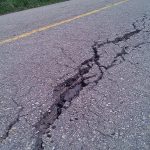 At the back end of last year I wrote about some interesting work that was using cooking oil to ‘self-heal’ our roads. The work was the brainchild of Dr Alvaro Garcia, who witnessed a contestant on the show using the spherification technique, which is a jellification of a liquid to form spheres that have a resemblance to caviar when submerged in water. This sparked the idea of placing capsules of oil inside the asphalt that forms our roads. Then, when the roads start to crack, each capsule opens and releases the oil inside, which in turn softens the surrounding asphalt. The idea that this helps the asphalt to ‘stick’ back together and thus fill in any cracks that are appearing.
At the back end of last year I wrote about some interesting work that was using cooking oil to ‘self-heal’ our roads. The work was the brainchild of Dr Alvaro Garcia, who witnessed a contestant on the show using the spherification technique, which is a jellification of a liquid to form spheres that have a resemblance to caviar when submerged in water. This sparked the idea of placing capsules of oil inside the asphalt that forms our roads. Then, when the roads start to crack, each capsule opens and releases the oil inside, which in turn softens the surrounding asphalt. The idea that this helps the asphalt to ‘stick’ back together and thus fill in any cracks that are appearing.
A second innovative project has recently been documented in a new paper. The work, from researchers at Binghamton University, uses fungi to ‘self-heal’ concrete. The researchers believe the problem of crumbling roads is caused by the smallest of cracks in the concrete.
“Without proper treatment, cracks tend to progress further and eventually require costly repair,” they explain. “If micro-cracks expand and reach the steel reinforcement, not only the concrete will be attacked, but also the reinforcement will be corroded, as it is exposed to water, oxygen, possibly CO2 and chlorides, leading to structural failure.”
Long-term fixes
The traditional approach has been to replace the ageing concrete, but of course this is a short-term fix until the concrete develops new cracks and the process starts over again. The researchers took inspiration from the human bodies ability to heal itself, with the body taking in nutrients to produce new substitutes and subsequently heal the damaged parts of the body.
It turned out a useful ally in replicating this in concrete was a fungus called Trichoderma reesei. It emerged that when you mix this fungus with concrete, it springs into life as soon as a crack appears.
“The fungal spores, together with nutrients, will be placed into the concrete matrix during the mixing process. When cracking occurs, water and oxygen will find their way in. With enough water and oxygen, the dormant fungal spores will germinate, grow and precipitate calcium carbonate to heal the cracks,” the team explain.
Then, when the cracks are filled and no more water or oxygen can enter, the fungi will form spores again.
Suffice to say, the work is still in a relatively early stage and more testing is required to explore whether it can work in the harshest of environments, but the team are optimistic that it will prove successful.
“There are still significant challenges to bring an efficient self-healing product to the concrete market. In my opinion, further investigation in alternative microorganisms such as fungi and yeasts for the application of self-healing concrete becomes of great potential importance,” they conclude.
Check out the video below to learn more about the work.